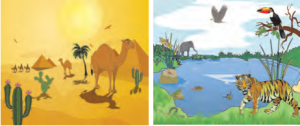Question Answers For All Chapters – General Science Class 8
Solutions
Exercise
1. Complete the following by using correct option.
(a) Air, water, minerals, and soil are physical factors of an ecosystem.
(b) River, ponds, and ocean are aquatic ecosystems.
(c) Man is a consumer in an ecosystem.
2. Match the following:
| Producers | Ecosystem |
|---|---|
| a. Cactus | 4. Desert |
| b. Aquatic plants | 3. Aquatic |
| c. Mangroves | 2. Creek |
| d. Pine | 1. Forest |
3. Give my information
(a) Ecosystem
- An ecosystem is a system where living (biotic) and non-living (abiotic) factors interact with each other.
- Example: Forest, pond, river, ocean.
(b) Biome
- A biome is a large ecosystem covering a vast area with similar climate and organisms.
- Example: Tropical rainforest, grassland, desert, ocean.
(c) Food Web
- A food web shows how different organisms in an ecosystem are connected through food.
- It consists of multiple food chains interlinked together.
4. Give Scientific Reasons:
(a) Plants in an ecosystem are called consumers.
- Plants produce their own food using sunlight through photosynthesis.
- They provide energy to all other living organisms in the ecosystem.
(b) Large dams destroy ecosystems.
- Large dams submerge forests and grasslands, converting them into aquatic ecosystems.
- They also reduce water flow, affecting aquatic plants and animals in rivers.
(c) Rhinos were restored in Dudhwa forest.
- Rhinos became extinct in Dudhwa due to excessive hunting.
- In 1984, rhinos were bred and reintroduced to protect the species.
5. Answer the following.
(a) What are the effects of increased population on ecosystems?
- More people need more resources, leading to deforestation, pollution, and habitat destruction.
- Excessive waste production affects land, water, and air quality.
(b) How is urbanization responsible for the destruction of ecosystems?
- Forests and wetlands are destroyed for buildings, roads, and cities.
- Wildlife loses its habitat, reducing biodiversity.
(c) What are the reasons for wars?
- Wars happen due to competition for land, water, minerals, political and economic conflicts.
- Wars destroy ecosystems, pollute air and water, and harm wildlife.
(d) Explain the interactions among the factors of an ecosystem.
- Abiotic factors (sunlight, water, soil) help plants grow, and plants provide food for animals.
- Animals (consumers) eat plants, and when they die, microbes (decomposers) break them down into nutrients.
(e) Differentiate between Evergreen Forests and Grasslands.
| Evergreen Forests | Grasslands |
|---|---|
| Found in high rainfall areas. | Found in areas with less rainfall. |
| Trees remain green throughout the year. | Covered mostly with grasses and few trees. |
| Example: Amazon Rainforest, Western Ghats. | Example: Savanna, Prairies, Indian grasslands. |
6. Describe the following pictures.
Forest Ecosystem: Shows trees, animals, and insects living together.
Aquatic Ecosystem: Shows fish, aquatic plants, and decomposers in a water body.
Food Web: Diagram of how energy flows between producers, consumers, and decomposers.


Leave a Reply